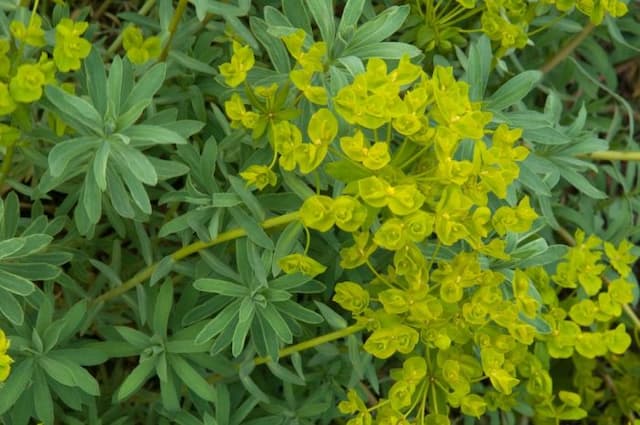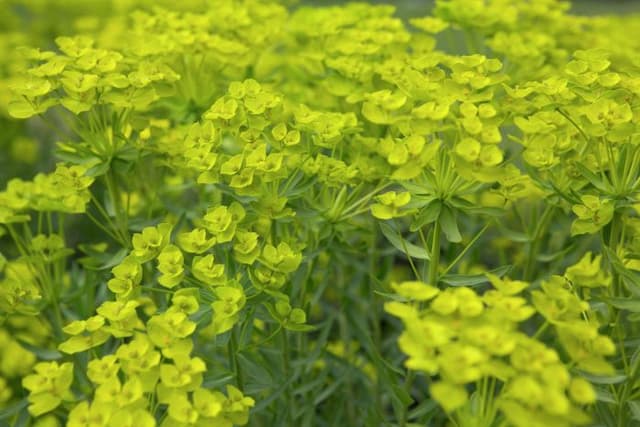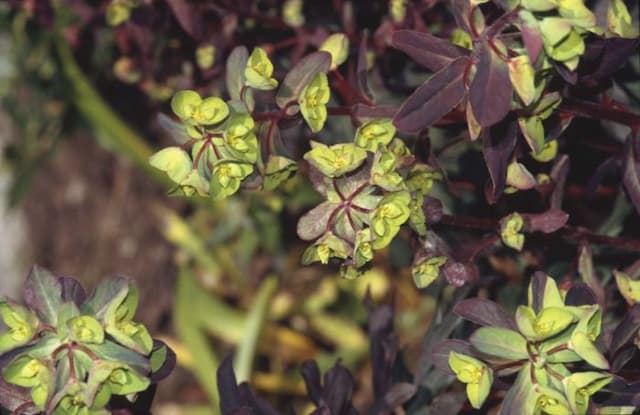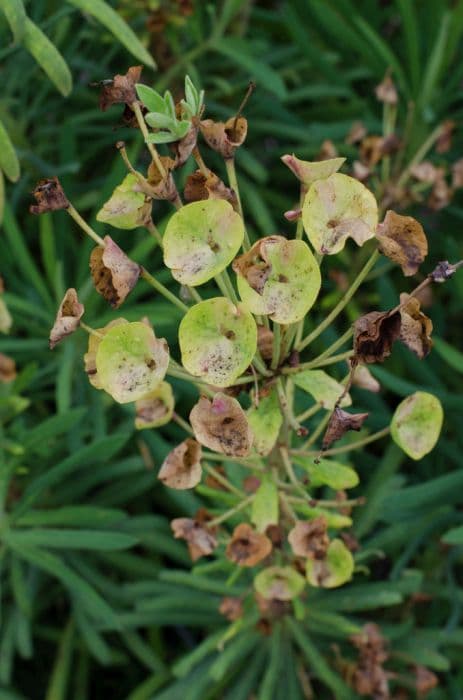Spurge Euphorbia 'Efanthia' (PBR)

ABOUT
Euphorbia 'Efanthia' is a striking ornamental plant that showcases a lush mound of dense foliage. Its leaves are a notable deep green color, with narrow, lance-shaped forms that create an elegant textural effect against the landscape or in a container garden. Throughout the growing season, Efanthia boasts a profusion of distinctive, tiny flowers which are clustered within cup-shaped bracts. These bracts are colored a vibrant yellow that contrasts beautifully with the green foliage. As the season progresses, the yellow blooms persist, adding a prolonged period of visual interest. The plant has a bushy, compact habit, presenting a neat and tidy appearance that works well in various garden settings. Notable for its drought tolerance once established, Efanthia exudes a milky sap when cut or broken. This sap is a characteristic feature of this type of plant, known for its unique attributes and care requirements.
About this plant
 Names
NamesSynonyms
Efanthia Spurge, Wood Spurge Efanthia.
Common names
Euphorbia 'Efanthia' (PBR).
 Toxicity
ToxicityTo humans
Spurge, specifically Euphorbia 'Efanthia', is considered toxic to humans due to the presence of a milky sap that contains compounds known as diterpene esters. If any part of the plant is ingested, the toxic sap can cause symptoms such as nausea, vomiting, and diarrhea. Additionally, if the sap comes into contact with the skin or eyes, it can lead to irritation, redness, swelling, and in severe cases, blistering or temporary blindness if introduced to the eyes. Care should be taken to avoid ingesting any part of the plant or getting the sap on the skin or in the eyes.
To pets
Spurge, specifically Euphorbia 'Efanthia', is considered toxic to pets because it contains a milky sap that has diterpene esters, which are harmful if ingested. The symptoms of poisoning in pets may include vomiting, diarrhea, and drooling. The irritation can also occur externally if the sap comes into contact with the pet's skin, leading to redness, swelling, and discomfort. If the sap comes into contact with the animal's eyes, it can cause severe pain and possibly temporary blindness. It is important to prevent pets from ingesting any part of the plant or coming into contact with the sap.
 Characteristics
CharacteristicsLife cycle
Perennials
Foliage type
Evergreen
Color of leaves
Green
Flower color
Yellow
Height
1-2 feet (30-60 cm)
Spread
1-2 feet (30-60 cm)
Plant type
Shrub
Hardiness zones
5-9
Native area
Mediterranean
Benefits
 General Benefits
General Benefits- Provides year-round interest with its evergreen foliage, making it an attractive addition to gardens across seasons.
- Displays a showy, long-lasting floral display when in bloom, which can add color and vibrancy to garden spaces.
- Is drought tolerant once established, requiring less water and maintenance than many other garden plants.
- Has a compact growth habit, making it suitable for container gardening or small garden beds without taking up too much space.
- Attracts pollinators like bees and butterflies, which can help pollinate other plants in the garden.
- Is deer-resistant, thus less likely to be damaged by deer in areas where this is a common garden challenge.
- Easy to propagate from cuttings, allowing gardeners to easily increase their stock or share with others.
- Adaptable to a range of soil types, though it prefers well-draining conditions, making it versatile for different garden settings.
- Can be pruned to shape, giving gardeners control over its appearance and size within the landscape.
 Medical Properties
Medical PropertiesThis plant is not used for medical purposes.
 Air-purifying Qualities
Air-purifying QualitiesThis plant is not specifically known for air purifying qualities.
 Other Uses
Other Uses- Euphorbia 'Efanthia' can be used as a natural dye source for fabrics or art projects. The sap or concentrated extracts from the plant can produce unique colors.
- As a companion plant in the garden, it can help deter certain pests that may be attracted to other nearby plants due to its toxic sap.
- It can serve as a model organism in botanical studies and education due to its unique physiological and structural characteristics.
- The plant’s distinctive texture and color can be used in photography as a subject for macro photography and botanical studies.
- In floral arrangements, Euphorbia 'Efanthia' adds a touch of drama and can be used to create interesting contrasts with other flowers.
- During festive seasons, it can serve as a natural decoration due to its vibrant appearance, especially when other plants are not in bloom.
- For artists, the plant's structure can provide inspiration for design, sculpture, and abstract art creations.
- Its robust nature makes it suitable for creating living walls or green structures in landscape architecture.
- Euphorbia 'Efanthia' can also be potted in creative containers, like repurposed items for an eco-friendly and artistic display.
- Its low water needs make it an ideal candidate for xeriscaping and designing sustainable, drought-resistant gardens.
Interesting Facts
 Feng Shui
Feng ShuiSpurge is not used in Feng Shui practice.
 Zodiac Sign Compitability
Zodiac Sign CompitabilitySpurge is not used in astrology practice.
 Plant Symbolism
Plant Symbolism- Resilience: Euphorbia, also known as Spurge, is a symbol of resilience due to its ability to thrive in harsh conditions and adapt to various environments.
- Protection: With its toxic sap, Euphorbia has been used as a protective charm in folklore to ward off evil and negative energy.
- Persistence: The hardy nature of the Spurge represents persistence and the determination to overcome obstacles in life.
- Healing: Historically, Euphorbia has been associated with healing due to its medicinal uses in traditional remedies, symbolizing the healing of both physical and emotional wounds.
- Purity: The color and form of Euphorbia can signify purity and cleanliness, perhaps stemming from its use in traditional medicine to cleanse and purify the body.
 Water
WaterWater Spurge 'Efanthia', also known as Euphorbia 'Efanthia', moderately allowing the soil to dry out slightly between waterings. Generally, this might equate to watering with about 1 gallon of water for a medium-sized plant every 1-2 weeks during the growing season, less during the dormant winter months. Adjust the watering frequency based on the humidity, temperature, and light conditions of your environment. Overwatering can lead to root rot, so ensure proper drainage. It’s essential to reduce watering in the cooler months to prevent soggy soil which can be detrimental to the plant's health.
 Light
LightSpurge 'Efanthia' thrives in bright, indirect light, making it ideal for a spot near a window that receives plenty of light but is shielded from direct sunlight. East or west-facing windows are often ideal spots, providing the balance of sun and shade that Euphorbia 'Efanthia' prefers. Avoid placing it in low light conditions, which can stunt growth and reduce vibrancy, as well as in very intense direct sunlight, which can scorch the leaves.
 Temperature
TemperatureSpurge 'Efanthia' prefers temperatures between 60 and 75°F, but it can tolerate a range down to about 50°F and up to around 85°F. Avoid exposure to temperatures under 50°F, as cold drafts or frost can damage the plant. The ideal conditions are consistent, moderate temperatures without sudden fluctuations, as extreme changes can stress the plant.
 Pruning
PruningPrune Spurge 'Efanthia' to remove any yellow or dead leaves and to shape the plant for aesthetic purposes or to control its size. Pruning is best done in late winter or early spring before the onset of new growth. This can be done annually or as required, using sterilized and sharp pruning shears to make clean cuts.
 Cleaning
CleaningAs needed
 Soil
SoilSpurge 'Efanthia' prefers a well-draining soil mix with a neutral to slightly acidic pH, ideally around 6.0 to 7.0. A mix of potting soil, perlite, and coarse sand in a 2:1:1 ratio supports good drainage and root health.
 Repotting
RepottingSpurge 'Efanthia' should be repotted every 2-3 years or when it outgrows its current pot, typically in the springtime before the growing season begins.
 Humidity & Misting
Humidity & MistingSpurge 'Efanthia' is tolerant of a wide range of humidity levels but does best in moderate humidity, neither too dry nor too humid, reflecting its Mediterranean origin.
 Suitable locations
Suitable locationsIndoor
Place in bright, indirect light and keep soil lightly moist.
Outdoor
Plant in full sun to part shade and well-drained soil.
Hardiness zone
5-9 USDA
 Life cycle
Life cycleEuphorbia 'Efanthia' begins its life as a seed that, when germinated in warm and moist conditions, sprouts and grows into a small seedling. The seedling then develops a root system and foliage, entering the vegetative stage where it grows actively, increasing in size and branching out. As the plant matures, it enters the flowering stage, producing characteristic, long-lasting bracts that surround small flowers, typically in the spring and summer. After pollination, which is often facilitated by insects, the plant sets seed, which, when mature, are dispersed by various means such as wind or contact with animals. Once the seeds are distributed, they enter a period of dormancy until conditions are favorable again for germination. Throughout its life cycle, Euphorbia 'Efanthia' can also propagate vegetatively through cuttings, which can root and grow into new plants, thereby continuing its cycle.
 Propogation
PropogationPropogation time
Spring-Early Summer
Euphorbia 'Efanthia', commonly known as spurge, is typically propagated through cuttings. The most popular method for propagation occurs during its active growth season, usually in spring or early summer. To propagate spurge by cuttings, a gardener would take a 3 to 6 inch (approximately 7.5 to 15 cm) stem cutting using a sharp, sterilized knife or pruning shears, making sure to include at least one set of leaves. The cut end of the stem should be allowed to dry and callous over for a day before being planted in a well-draining potting mix. The cutting should be kept in a warm, bright spot, avoiding direct sunlight, to encourage rooting. It's important to keep the soil moist but not overly wet to prevent rot. After a few weeks, the cutting should begin to develop roots, being ready to transplant when a strong root system has established.









